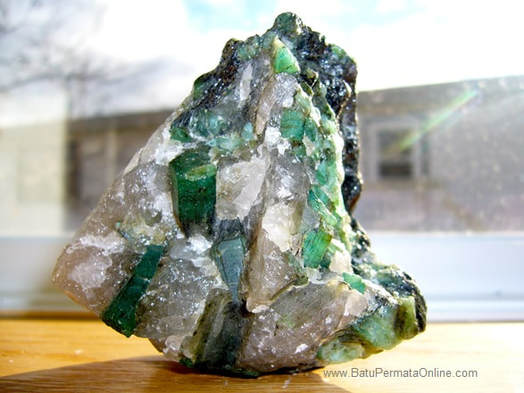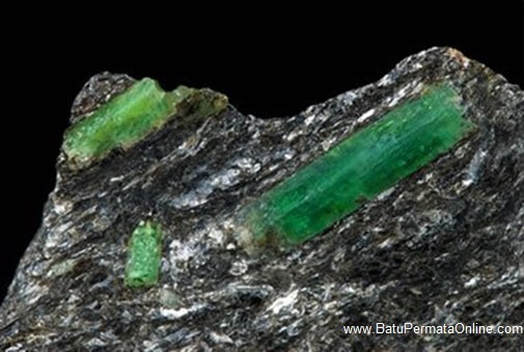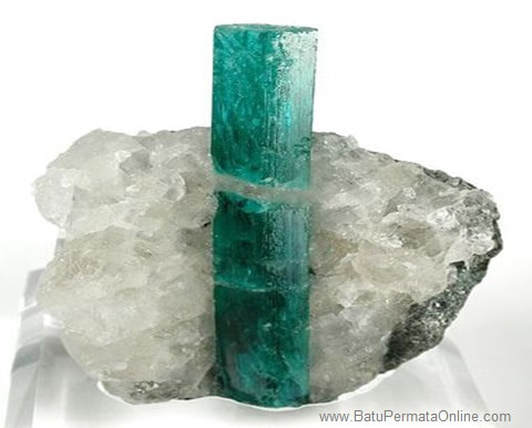What is meant by Emerald ?
Emerald is a green gemstone, a specimen from the mineral family Beryl. They are found in igneous rocks, and sedimentary rocks in a small number of locations around the world. They are highly valued stones used for jewellery. Gems generally get their colour because of certain trace metals or impurities contained in the mineral, and in the case of emeralds, they contain traces of chromium, or sometimes vanadium, giving them an intense green colour.
For more than 5000 years, Emerald has become one of the most desirable and valuable colored gemstones. ancient civilizations in Africa, Asia and South America discovered emeralds and made the most valuable gemstones. Today emeralds, together with Ruby and Sapphire, form "three major types of gemstones" from colored stones. Beryl (mineral from Emerald stone) is a variety that has a chemical composition of Be3Al2 (SiO3). The content of chromium or vanadium in minerals in emeralds is the cause of the green stone. the amount of trace iron will color the bluish green Emerald or yellowish green color depending on its oxidation state.
Emerald is defined by green. To become an Emerald, the specimen must have a distinctive green color that falls in the range from bluish green to slightly yellowish green. To be Emerald, the specimen must also have a rich color. Stones with weak saturation or light tones should be called "green beryl." If the beryl color is turquoise then it is "aquamarine." If it's greenish it's "Heliodor." The combination of hue, tone, and saturation is the dividing line between "green beryl" and "emerald"? Professionals in gems and trade jewelry do not agree on where the line must be drawn. Some believe that the name "Emerald" should be used if chromium is the cause of green, and that colored stones with vanadium must be called "green beryl." An "emerald" instead of "green beryl" has a significant impact on price and marketing.
For more than 5000 years, Emerald has become one of the most desirable and valuable colored gemstones. ancient civilizations in Africa, Asia and South America discovered emeralds and made the most valuable gemstones. Today emeralds, together with Ruby and Sapphire, form "three major types of gemstones" from colored stones. Beryl (mineral from Emerald stone) is a variety that has a chemical composition of Be3Al2 (SiO3). The content of chromium or vanadium in minerals in emeralds is the cause of the green stone. the amount of trace iron will color the bluish green Emerald or yellowish green color depending on its oxidation state.
Emerald is defined by green. To become an Emerald, the specimen must have a distinctive green color that falls in the range from bluish green to slightly yellowish green. To be Emerald, the specimen must also have a rich color. Stones with weak saturation or light tones should be called "green beryl." If the beryl color is turquoise then it is "aquamarine." If it's greenish it's "Heliodor." The combination of hue, tone, and saturation is the dividing line between "green beryl" and "emerald"? Professionals in gems and trade jewelry do not agree on where the line must be drawn. Some believe that the name "Emerald" should be used if chromium is the cause of green, and that colored stones with vanadium must be called "green beryl." An "emerald" instead of "green beryl" has a significant impact on price and marketing.
Emeralds hold a unique distinction in the world of gemstones as they are one of the four traditionally considered to be precious. Along with diamonds, rubies and sapphires, the emerald has a long history as a sought after gem thanks to its unique green color and relative rarity.
Emeralds in calcite and shale matrix from the Coscuez Mine, Muzo, Colombian. A well formed crystal with an attractive green color is about 1.1 centimeters. Colombia Green to Blue Emerald Color. Colombia is the world's largest emerald producer, accounting for up to 95% of the world's emerald production, according to some estimates.
Emeralds in calcite and shale matrix from the Coscuez Mine, Muzo, Colombian. A well formed crystal with an attractive green color is about 1.1 centimeters. Colombia Green to Blue Emerald Color. Colombia is the world's largest emerald producer, accounting for up to 95% of the world's emerald production, according to some estimates.
Brazilian Emerald (a variety of green grass from mineral beryl) in a quartz-pegmatite matrix with typical hexagonal and prismatic crystals.
Emerald crystal photos on mica schist from Malyshevskoye Mine, Sverdlovsk Region, Southern Ural, Russia. Large crystal emeralds are about 21 millimeters in length. Green Russian Emerald Color to brass.
Emerald Crystal from Kagem Emerald Mine, Zambia. on the quartz matrix and schist mica. this specimen is about 6.5 cm high and has a blue-green color and is a little dark.
Why is emerald so expensive?
Emeralds are rarer and often more expensive than diamonds
When it comes to rare and expensive gemstones, most of us immediately think of Diamonds, but, in fact, emeralds are more than 20 times rarer than diamonds and, therefore, often command a higher price.
Why is emerald so expensive?
Emeralds are rarer and often more expensive than diamonds
When it comes to rare and expensive gemstones, most of us immediately think of Diamonds, but, in fact, emeralds are more than 20 times rarer than diamonds and, therefore, often command a higher price.






